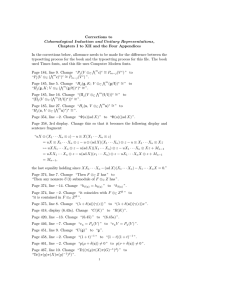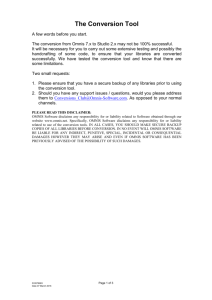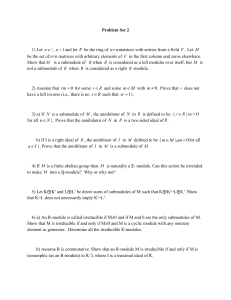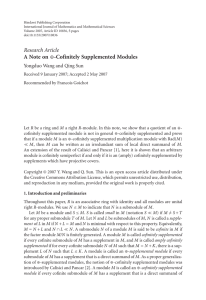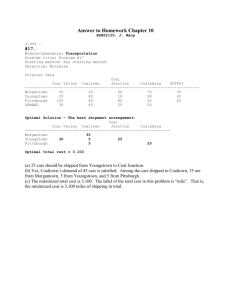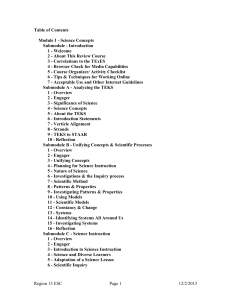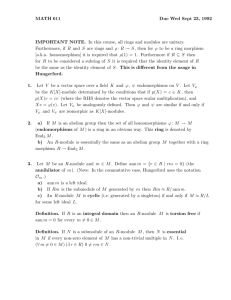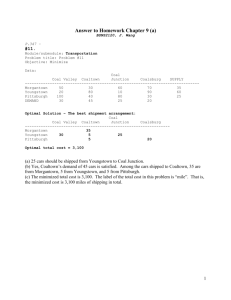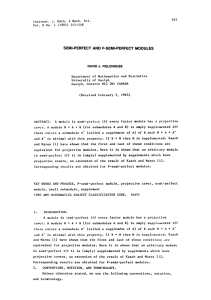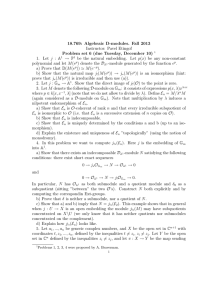τ -SUPPLEMENTED MODULES AND τ -WEAKLY SUPPLEMENTED MODULES Muhammet Tamer Kos ¸an
advertisement
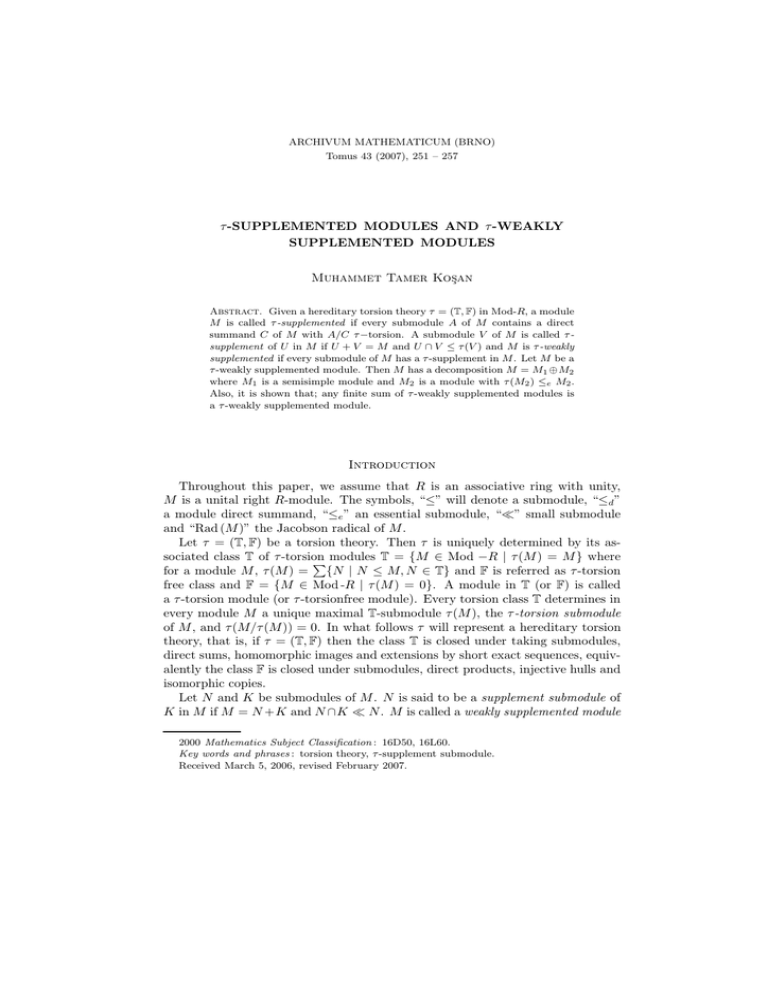
ARCHIVUM MATHEMATICUM (BRNO)
Tomus 43 (2007), 251 – 257
τ -SUPPLEMENTED MODULES AND τ -WEAKLY
SUPPLEMENTED MODULES
Muhammet Tamer Koşan
Abstract. Given a hereditary torsion theory τ = (T, F) in Mod-R, a module
M is called τ -supplemented if every submodule A of M contains a direct
summand C of M with A/C τ −torsion. A submodule V of M is called τ supplement of U in M if U + V = M and U ∩ V ≤ τ (V ) and M is τ -weakly
supplemented if every submodule of M has a τ -supplement in M . Let M be a
τ -weakly supplemented module. Then M has a decomposition M = M1 ⊕M2
where M1 is a semisimple module and M2 is a module with τ (M2 ) ≤e M2 .
Also, it is shown that; any finite sum of τ -weakly supplemented modules is
a τ -weakly supplemented module.
Introduction
Throughout this paper, we assume that R is an associative ring with unity,
M is a unital right R-module. The symbols, “≤” will denote a submodule, “≤d ”
a module direct summand, “≤e ” an essential submodule, “≪” small submodule
and “Rad (M )” the Jacobson radical of M .
Let τ = (T, F) be a torsion theory. Then τ is uniquely determined by its associated class T of τ -torsion
P modules T = {M ∈ Mod −R | τ (M ) = M } where
for a module M , τ (M ) = {N | N ≤ M, N ∈ T} and F is referred as τ -torsion
free class and F = {M ∈ Mod -R | τ (M ) = 0}. A module in T (or F) is called
a τ -torsion module (or τ -torsionfree module). Every torsion class T determines in
every module M a unique maximal T-submodule τ (M ), the τ -torsion submodule
of M , and τ (M/τ (M )) = 0. In what follows τ will represent a hereditary torsion
theory, that is, if τ = (T, F) then the class T is closed under taking submodules,
direct sums, homomorphic images and extensions by short exact sequences, equivalently the class F is closed under submodules, direct products, injective hulls and
isomorphic copies.
Let N and K be submodules of M . N is said to be a supplement submodule of
K in M if M = N +K and N ∩K ≪ N . M is called a weakly supplemented module
2000 Mathematics Subject Classification : 16D50, 16L60.
Key words and phrases : torsion theory, τ -supplement submodule.
Received March 5, 2006, revised February 2007.
252
M. T. KOŞAN
if every submodule of M has a supplement in M . The module M is called a ⊕supplemented module if every submodule of M has a supplement that is a direct
summand of M . Supplemented modules and its variations have been discussed
by several authors in the literature and these modules are useful in characterizing
semiperfect modules and rings.
Given a hereditary torsion theory τ = (T, F) in Mod -R, τ -complemented modules are studied in [8]. Dually, a module M is said to be a τ -supplemented module
if every submodule A of M contains a direct summand C of M with A/C τ -torsion
[4]. Some further properties of τ −supplemented were studied in [4] and [5].
In this note, we define τ -supplement and τ -weakly supplemented modules. In
Section 2, we will show that
Theorem. Let M be a τ -weakly supplemented module. Then
(1) If M is τ -torsionfree, then M is τ -weakly supplemented if and only if M is
semisimple.
(2) Every homomorphic image of M is again a τ -weakly supplemented module.
(3) M/τ (M ) is semisimple
and
Theorem. Any finite sum of τ -weakly supplemented modules is a τ -weakly supplemented module.
In [6], the authors defined and characterized perfect module and ring relative to
a torsion theory. In this note, we define semiperfect module relative to a torsion
theory and we will prove that
Theorem. M is a τ -semiperfect module if and only if M is a τ -weakly supplemented module and each τ -supplement submodule of M is a τ -projective cover.
We refer the reader to [3] and [9] as torsion theoretic sources sufficient for our
purposes and [1] and [10] for the other notations in this paper.
1. τ -suplemented modules and τ -weakly suplemented modules
Let τ = (T, F) be a hereditary torsion theory in Mod -R and M be a right
R-module. Following [4], M is said to be a τ -supplemented module if every
submodule A of M contains a direct summand C of M with A/C τ -torsion.
Firstly, we give some properties of τ -supplemented modules:
Theorem 1.1.
(1) Let M be a module. Then the following are equivalent
(a) M is a τ -supplemented module.
(b) Every submodule A of M can be written as A = B ⊕ C with B a direct
summand of M and τ (C) = C.
(c) For every submodule A of M , there exist a decomposition M = X ⊕ X ′
with X ≤ A and X ′ ∩ A ≤ τ (X ′ ).
(d) For every submodule A of M , there is an idempotent
e ∈ End (MR ) such
that e(M ) ⊆ A and (1 − e)(A) ≤ τ (1 − e)A .
τ -SUPPLEMENTED MODULES AND τ -WEAKLY SUPPLEMENTED MODULES
(2) Let
(a)
(b)
(c)
(d)
(e)
(f)
(g)
(h)
253
M be a τ -supplemented module. Then
Every submodule of M is a τ -supplemented module.
Every τ -torsionfree submodule of M is a direct summand of M .
Every submodule N of M with N ∩ τ (M ) = 0 is a direct summand of
M . In particular, if M is τ -torsionfree, then M is τ -supplemented if
and only if M is semisimple.
M/τ (M ) is semisimple.
For any submodules K, N of M such that M = N + K, there exist
a submodule X of N with M = K + X and K ∩ X ⊆ τ (X).
Rad (M ) ≤ τ (M ).
If τ (M ) 6= Rad (M ), then M has a nonzero direct summand with τ torsion.
τ (M ) = Rad (M ) or M has a nonzero τ -torsion submodule that is a direct summand of M .
Proof. (1)(a)⇔(b) and (2)(a) are [4, Lemma 2.1].
(1)(a)⇔ (c) and (a)⇔(d) are obvious.
(2)(b) Is [4, Lemma 2.5].
(2)(c) Is [4, Corollary 2.6].
(2)(d) By [5, Theorem 4.8].
(2)(e) Let M be a τ -supplemented and K, N be submodules of M with M = N +K.
By (2)(a), N is a τ -supplemented module. Then there exist a submodule X of N
such that N = N ∩ K + X and N ∩ K ∩ X is τ -torsion and so N ∩ K ∩ X ≤ τ (X).
Note that M = X + K. It is clear that K ∩ X = N ∩ K ∩ X ≤ τ (X).
(2)(f) By (2)(d), M/τ (M ) is semisimple and so Rad (M ) ≤ τ (M ).
(2)(g) Assume that τ (M ) 6= Rad (M ). Then there exist a maximal submodule P
of M such that τ (M ) is not contained in P . Since M is τ -supplemented, there
exists a submodule X of K such that M = X ⊕ X ′ and P ∩ X ′ ≤ τ (X ′ ) by
(1)(c). Note that P ∩ X ′ is also maximal submodule of X ′ . We may assume that
τ (X ′ ) = X ′ . Thus M = X ⊕ X ′ , where X ′ = τ (X ′ ).
(2)(h) Clear from (2)(d) and (g). Also, it follows from [5, Theorem 4.9].
As we mentioned in introduction, a submodule V of M is called supplement of U
in M if V is a minimal element in the set of submodules L of M with U + L = M .
So V is a supplement of U if and only if U + V = M and U ∩ V is small in V . An
R-module M is weakly supplemented if every submodule of M has a supplement
in M .
After considering several possible definitions for a supplement module in a torsion theory, by Theorem 2.1, we propose as; a submodule V of M is called τ supplement of U in M if U + V = M and U ∩ V ≤ τ (V ) and M is said to be
a τ -weakly supplemented module if every submodule of M has a τ -supplement in
M . Clearly, every τ -supplemented is a τ -weakly supplemented.
254
M. T. KOŞAN
Lemma 1.2. Let M be a module and V ≤ M .
(1) If V is a τ -torsionfree τ -supplement submodule, then V is a direct summand
of M .
(2) If τ (M ) = 0, then every τ -supplement submodule of M is a direct summand.
(3) If V is a τ -supplement submodule of M and V ′ ⊆ V , then V /V ′ is also
τ -supplement submodule of M/M ′ .
Proof. Trivial.
Theorem 1.3. Let M be a τ -weakly supplemented module. Then
(a) If M is τ -torsionfree, then M is τ -weakly supplemented if and only if M is
semisimple.
(b) Every homomorphic image of M is again a τ -weakly supplemented module.
(c) M/τ (M ) is semisimple.
Proof. They are consequences of Lemma 2.2.
The class of τ -supplemented module is not closed under direct sums. Therefore,
there are some decompositions theorems for τ - supplemented modules, for example:
A τ -supplemented module M has a decomposition M = M1 ⊕ M2 where M1 is
a semisimple module and M2 is a τ -supplemented module with τ (M2 ) ≤e M2 (see
[4, Lemma 2.7]).
Lemma 1.4.
(1) Let M be a τ -weakly supplemented module. Then M has a decomposition
M = M1 ⊕ M2 where M1 is a semisimple module and M2 is a module with
τ (M2 ) ≤e M2 .
(2) For submodules N, K of M , if N is a τ -weakly supplemented module and
N + K has a τ -supplement in M then K has a τ -supplement in M .
Proof. (1) For the proof, we completely follow the proof of [4, Lemma 2.7]. If
τ (M ) ≤e M , then proof is clear. Assume not. Let N ≤ M be a complement of
τ (M ). Therefore N ⊕ τ (M ) ≤e M . By Theorem 2.3, N is a semisimple module.
Since M is τ -supplemented module, there exists a submodule X of M such that
M = N + X and N ∩ X ≤ τ (X). Note that N ∩ X = N ∩ (N ∩ X) ≤ N ∩ τ (X) ≤
N ∩ τ (M ) = 0. This implies M = N ⊕ X and τ (M ) = τ (N ) ⊕ τ (X) = τ (X)
because τ (N ) = 0. Therefore, we have τ (X) ≤e X.
(2) Because N + K has a τ -supplement in M , let A be a submodule of M with
M = (N + K) + A and (N + K) ∩ A ≤ τ (A). Since N is τ -weakly supplemented
module, there exists a submodule B of N such that [(K + A) ∩ N ] + B = N and
[(K +A)∩N ]∩B ≤ τ (B). Hence M = K +A+B and B is a τ -supplement of K +A
in M . We claim that A + B is a τ -supplement of K in M . Since B + K ≤ N + K,
we have A ∩ (B + K) ≤ τ (A). Now, (A + B) ∩ K ≤ τ (A) + τ (B) ≤ τ (A + B).
The following theorem generalizes a part of [2, 17.13].
Theorem 1.5. Any finite sum of τ -weakly supplemented modules is τ -weakly supplemented module.
τ -SUPPLEMENTED MODULES AND τ -WEAKLY SUPPLEMENTED MODULES
255
Proof. Let M1 and M2 be τ -weakly supplemented modules and M = M1 + M2 .
Let N be a submodule of M . Clearly, M1 + M2 + N has a τ -supplement 0 in M .
By Lemma 2.4, M2 + N has a τ -supplement in M . Again by Lemma 2.4, N has
a τ -supplement in M . This implies that M = M1 + M2 is τ -weakly supplemented
module.
We recall that a module M is τ -projective if and only if it is projective with
respect to every R-epimorphism having a τ -torsion kernel [3].
Lemma 1.6. Let M be a module and L a direct summand of M and K a submodule
of M such that M/K is τ −projective and M = L + K and L ∩ K is τ −torsion.
Then L ∩ K is direct summand of M .
Proof. Let M = L ⊕ L′ and α : M/L′ → L be the isomorphism and β : L →
M/K ∼
= L/(L ∩ K) the epimorphism that having L ∩ K as kernel. Then we have
epimorphism βα : M/L′ → M/K having kernel ((L ∩K)⊕ L′)/L′ ∼
= L ∩K which is
τ −torsion. Since M/K is τ −projective, there exists g : M/K → M/L′ such that
1 = βαg. Hence L ∩ K is direct summand.
An epimorphism f : P → M is called a τ -projective cover of M if P is τ projective and Ker (f ) is small τ -torsion submodule of P (see [3, Page 117]).
Lemma 1.7.
(1) If f : P → N is a τ -projective cover and g : N → M is a τ -projective cover,
then gf : P → M is a τ -projective cover.
(2) The following are equivalent for a module M and N ≤ M .
(a) If M/N has a τ -projective cover.
(b) N has a τ -supplement K in M which has a τ - projective cover.
(c) If N ′ is a submodule of M with M = N +N ′ , then N has a τ -supplement
X such that X ≤ N ′ and X has a τ -projective cover.
Proof. (1) For the proof, we claim that Ker (gf ) is small τ -torsion. By [7, Lemma
4.2], Ker (gf ) is small. Let x ∈ Ker (gf ). Then f (x) ∈ Ker (g) ≤ τ (N ) = f τ (P ) .
For any p ∈ τ (P ), we have f (x) = f (p), and so x − p ∈ (f )τ (P ), that is x ∈ τ (P ).
(2)(a)⇒(c) is [6, Lemma 3.1].
(2)(a)⇒(b) is [6, Lemma 3.3].
(2)(c)⇒(b) is clear.
(2)(b)⇒(a) assume N has a τ -supplement K in M which has a τ -projective cover,
that is f : P → K with Ker (f ) is small τ -torsion. Let g : K → K/(N ∩ K). It
is easy to see that, Ker (g) small τ -torsion. Since N/N ∩ K = M/N , we have
gf : P → M/N is τ -projective cover of M/N by (1).
Following [6], a module M is said to be a τ − ⊕-supplemented when for every
submodule N of M there exists a direct summand K of M such that M = N + K
and N ∩ K is τ -torsion, and M is called a completely τ − ⊕-supplemented if every
direct summand of M is τ − ⊕-supplemented and the module M is called strongly
τ − ⊕-supplemented if for any submodule N of M there exists a direct summand
K of M with M = N + K and N ∩ K is small τ -torsion in K by [6].
256
M. T. KOŞAN
Theorem 1.8. Let P be a projective R−module. Then the following are equivalent:
(1) P is τ −supplemented.
(2) P is τ − ⊕−supplemented.
Proof. (1) ⇒ (2) Clear from definitions.
(2) ⇒ (1) Let N be submodule of P . By (2), there exists a direct summand K of
P such that P = N + K = K ′ ⊕ K and N ∩ K is τ − torsion. By [7, Lemma 4.47],
there exists a direct summand L of P such that P = L ⊕ K and L ≤ N . Since
N/L is isomorphic to N ∩ K, N/L is τ −torsion. (2) follows.
In [6], a ring R is called a right τ -perfect ring if every right R-module has a τ projective cover (compare with [11, Remark 4.5]). Every right τ -perfect ring is
right perfect, and any strongly τ − ⊕-supplemented module is τ − ⊕-supplemented.
Theorem 1.9. Let R be a ring. Then the following are equivalent.
(1) R is a right τ -perfect ring.
(2) Every projective R-module is a strongly τ − ⊕-supplemented module.
Proof. (1) ⇒ (2) Let N be submodule of the projective module M . By (1), M/N
has τ -projective cover. By Lemma 2.7, there exists a submodule L of M such that
M = N + L with N ∩ L is small and τ -torsion in L. Again by Lemma 2.3, N
contains a submodule K such that M = K + L with K ∩ L is small and τ -torsion
in K. By [6, Lemma 3.2], K ∩ L = 0. Hence M = N + L = K ⊕ L and N ∩ L is
small and τ −torsion in L. It follows that M is strongly τ − ⊕-supplemented.
(2) ⇒ (1) Let M be any R-module, P a projective module and f an epimorphism
f : P −→ M . By (2), P has direct summands K and K ′ so that P = Ker (f )+K =
K ′ ⊕ K with Ker (f ) ∩ K small and τ - torsion in K. Hence K is the required τ projective cover of M .
Similar to τ -perfect module, we call a module M τ -semiperfect if every homomorphic image of M has a τ -projective cover.
Theorem 1.10. The following are equivalent for a module M
(1) M is a τ -semiperfect module;
(2) M is a τ -weakly supplemented module and each τ -supplement submodule of
M has τ -projective cover.
(3) For any submodules K, N of M such that M = N + K, there exist a τ supplement submodule X of N that X has a τ -projective cover.
Proof. Clear from Lemma 2.7 and Theorem 2.1.
Acknowledgments. The author thanks to the editor Prof. Jan Trlifaj and referee
for his/her valuable suggestions. Special thanks to Prof. Abdullah Harmanci for
his encouragement and direction.
τ -SUPPLEMENTED MODULES AND τ -WEAKLY SUPPLEMENTED MODULES
257
References
[1] Anderson, F. W., Fuller, K. R., Rings and Categories of Modules, Springer-Verlag, New
York, 1992.
[2] Clark, J., Lomp, C., Vanaja, N., Wisbauer, R., Lifting Modules, Birkhäuser, Basel, 2006.
[3] Golan, J. S., Torsion Theories, Pitman Monographs and Surveys in Pure and Applied
Mathematics 29, New York, John Wiley & Sons, 1986.
[4] Koşan, T., Harmanci, A., Modules supplemented with respect to a torsion theory, Turkish
J. Math. 28 (2), (2004), 177–184.
[5] Koşan, M. T., Harmanci, A., Decompositions of Modules supplemented with respect to a torsion theory, Internat. J. Math. 16 (1), (2005), 43–52.
[6] Koşan, M. T., Harmanci, A., ⊕-supplemented modules relative to a torsion theory, NewZealand J. Math. 35 (2006), 63–75.
[7] Mohamed, S. H., Müller, B. J., Continuous and discrete modules, London Math. Soc. LNS
147, Cambridge Univ. Press, Cambridge (1990).
[8] Smith, P. F., Viola-Prioli, A. M., and Viola-Prioli, J., Modules complemented with respect
to a torsion theory, Comm. Algebra 25 (1997), 1307–1326.
[9] Stenström, B., Rings of quotients, Springer Verlag, Berlin, 1975.
[10] Wisbauer, R., Foundations of module and ring theory, Gordon and Breach, Reading, 1991.
[11] Zhou, Y., Generalizations of perfect, semiperfect, and semiregular rings, Algebra Colloquium 7 (3), (2000), 305–318.
Faculty of Science, Gebze Institute of Techonology
Çayirova Campus, 41400 Gebze- Kocaeli, Türkiye
E-mail : mtkosan@gyte.edu.tr
